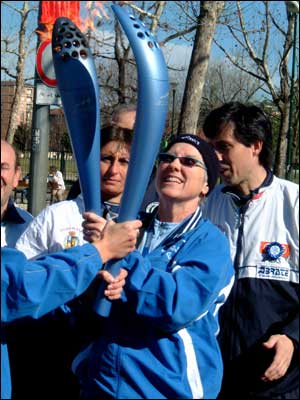Anne Hart’s childhood dream of one day being in the Olympics came true in a way she never imagined.
Hart, an associate professor in the Department of Rehabilitation Sciences, fulfilled her dream by carrying the torch that ignited the start of the Paralympics in Torino, Italy, where she volunteered classifying athletes with disabilities.
“With these experiences I get more than just exposure to the medical side of disabilities. I witness how the quality of life is enhanced through exercise and sports,” Hart said.
The Paralympics are the Olympics of the disability world. They began in 1960 to emphasize participants’ athletic achievement rather than their disability. Almost 4,000 athletes from more than 135 countries compete. The games occur right after the Olympics and use the same villages and venues.
Hart, a physical therapist who teaches neurological rehabilitation for people with spinal cord injuries, was in Torino from March 4 through 19 working on the classification committee that evaluates athletes with disabilities so they compete with other athletes with similar disabilities. Games included wheelchair ice hockey and blind skiing, where a downhill skier competes with a partner instructing their route.
“The games help me demonstrate to my students how health and wellness is an important part of life for people with disabilities,” she said. “As a physical therapist you don’t just work on the body. You are the coach and the motivator. You have to believe that life will be ok again for these people so they can believe it too.”
Part of Hart’s curriculum is teaching how different sports can help strengthen and rehabilitate people with disabilities. In 2004, she took a sabbatical and volunteered for the International Paralympic Committee headquarters in Bonn, Germany, to help coordinate the games. She was also a classifier at the Sydney 2000 summer Paralympics, and plans to work at the 2008 summer games in Beijing.
Hart said she was a swimmer in her youth and hoped to one day experience the world games, but knew her swimming would not get her there.
“It’s funny how things work out,” she said. “I had the honor of carrying the torch at the Paralympics for about 15 minutes. It was a beautiful experience to be part of something symbolizing the peace and magic of the games. Crowds were cheering me on and I felt like a rock star.”
She said the U.S. media doesn’t cover the games to the extent that other countries do.
“The Paralympics are a big deal in most of the world,” Hart explained. “The prefix ‘para’ means these competitions are parallel to those in the Olympics.”
Paralympic athletes from Canada train at NAU’s Center for High Altitude Training. At the 2004 Summer Paralympics in Athens, 11 out of 14 of the athletes who trained at NAU won a total of 41 medals.
“We’re proud to serve the Paralympics athletes at NAU and appreciative that we have resources here like Anne Hart, who is an expert in the field,” said Natalie Harlan, director of the center.
For information click here.



